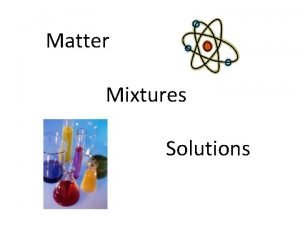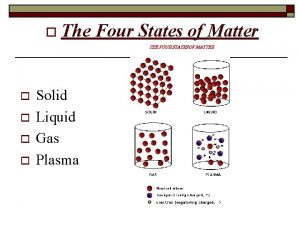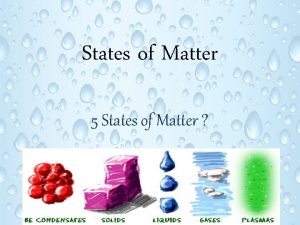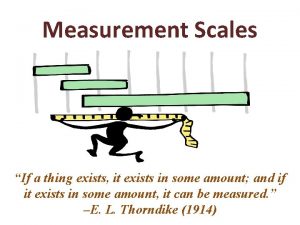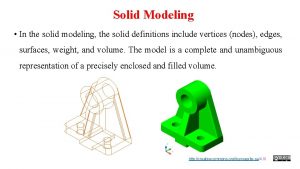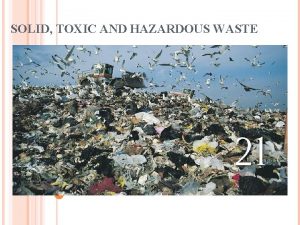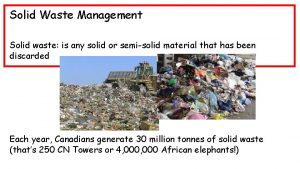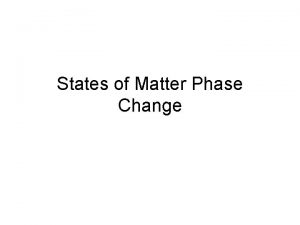States of Matter Matter exists as Solid 1


















- Slides: 18

States of Matter

Matter exists as: *_____Solid_______: 1. Dense, incompressible, highly organized structure, usually crystalline. 2. Definite shape, definite volume. ** __amorphous__ _____solid___: A solid that lacks a rigid internal structure.

*___Liquid_______: 1. Fluid, slightly compressible, held together by +/- forces between particles. 2. Indefinite shape, definite volume. ** ____Glass_____ Transparent, inorganic products of fusion that have cooled to a rigid state, without crystallizing.

*_____Gas______: 1. Fluid, easily compressed, mostly large empty spaces with particles scattered throughout. 2. No positive or negative forces exist between particles. 3. Indefinite shape, indefinite volume. *____Plasma_________: 1. Stream of electrons and positive ions. 2. Exist only at extremely high temperatures (> 5000°C).


Phase changes occur due to a change in energy and/or temperature. Phase changes are PHYSICAL changes. As heat is absorbed or released in a phase change, the change in energy, not temperature, caused the change to occur.

Phase Changes n io at lim su b ep D solid at io n tio i s o riz sa en n o ti va po nd co gas n melting liquid freezing

Solid to liquid Melting point and freezing point of a substance occur at the same temperature. Covalent Compounds usually have low melting points. Ionic Compounds usually have high melting points.

Liquid to a gas • Vapor: The gas phase of a substance that normally exists as a liquid or solid. • Evaporation: Change of a liquid to a gas/vapor at a temperature below its boiling point. • Boiling : Change of a liquid to a gas/vapor at a temperature when the vapor pressure of a liquid equals the external pressure

• Normal boiling point: The temperature at which a liquid boils at standard pressure • Elevation and atmospheric pressure are inversely proportional. • Elevation and boiling point are inversely proportional.

Phase Diagrams

Terms to Know… Triple point Normal MP and Normal BP Critical Point

Heating Curve

Phase Diagram * At any point on a line, the two phases bordering the line are in equilibrium. * At any other point (not on a line), only one phase exists. * A phase change can be caused by changing one or both variables (temperature or pressure). *_Critical Temperature: The highest temperature at which a substance can exist as a liquid (regardless of pressure). *Triple Point: Point at which all three phases co-exist in equilibrium.

Intramolecular Forces within a particle – Ionic – attraction between anions and cations – Covalent – attraction between a nucleus and shared electrons – Metallic – attraction between metal cations and mobile electrons

Intermolecular Forces Force of Attraction between particles – Dipole-dipole: attraction between + and – ends of two polar molecules. – Hydrogen bonding: attraction between hydrogen atoms and atoms with high electronegativities in other molecules. H to N or O or F

London Dispersion forces: Very slight attraction between all atoms due to “polar moments” caused by the movements of electrons. – Used to explain why gases can be liquefied.

Arrange the following gases in order of increasing boiling point: A. H 2 B. NH 3 C. HCl D. HF E. Na. Cl
 States of matter solid liquid gas
States of matter solid liquid gas Plasma particle arrangement
Plasma particle arrangement Anisotropic
Anisotropic Polycrystalline solids
Polycrystalline solids When a solid completely penetrates another solid
When a solid completely penetrates another solid Crystalline solid and amorphous solid
Crystalline solid and amorphous solid Crystalline solid
Crystalline solid When a solid completely penetrates another solid
When a solid completely penetrates another solid Example of solid solution
Example of solid solution Crystalline solid and amorphous solid
Crystalline solid and amorphous solid Separation examples
Separation examples Covalent network solid vs molecular solid
Covalent network solid vs molecular solid What were the 11 free states
What were the 11 free states Southern states of america
Southern states of america Big states vs small states guard against tyranny
Big states vs small states guard against tyranny State of matter concept map
State of matter concept map Example of deposition
Example of deposition Examples of gas
Examples of gas States of matter jeopardy
States of matter jeopardy
